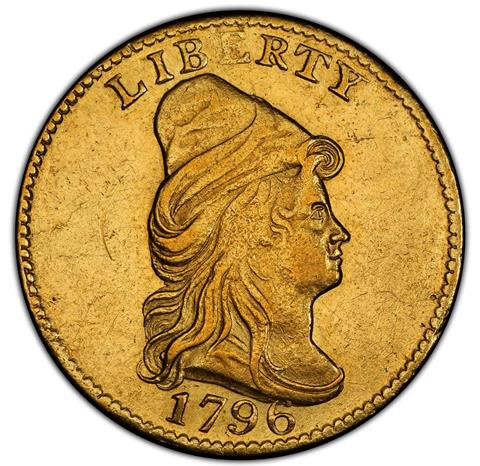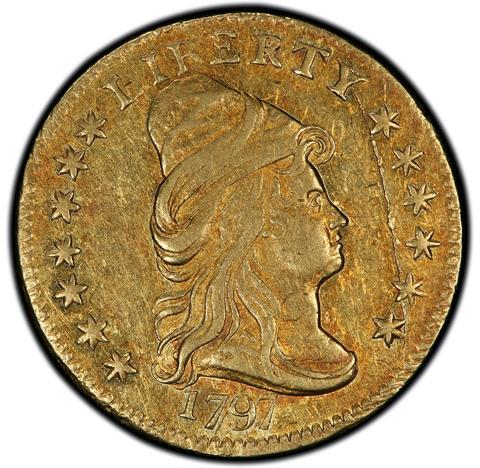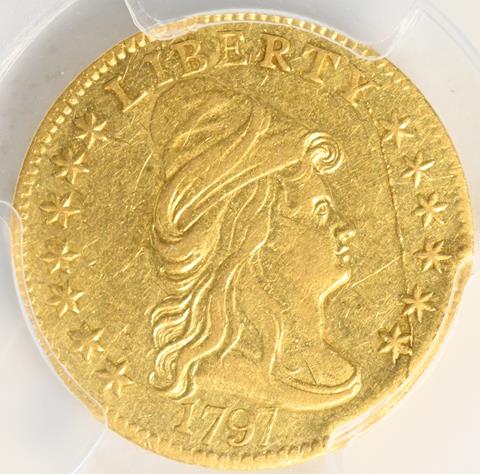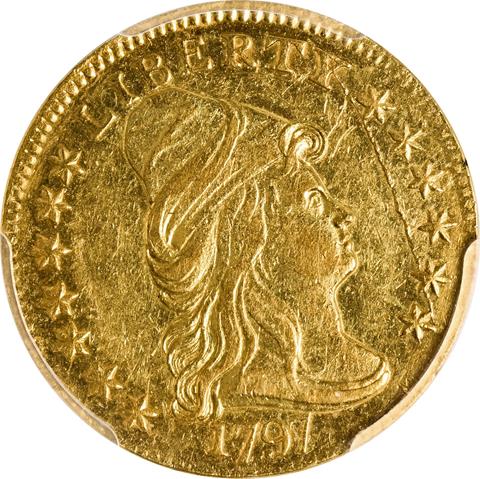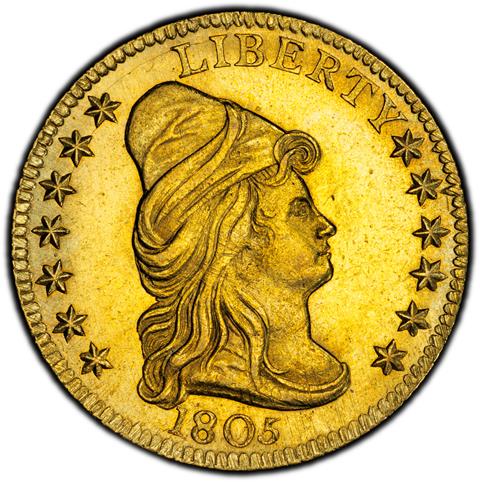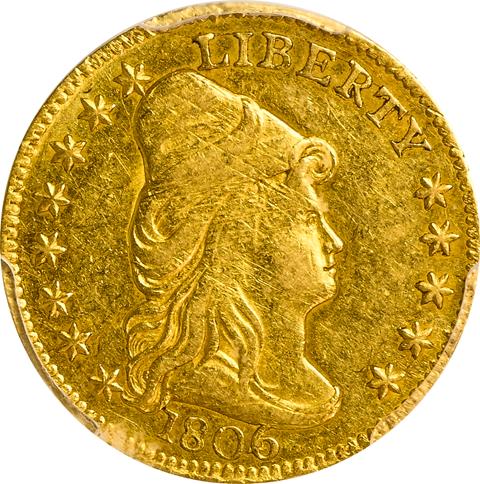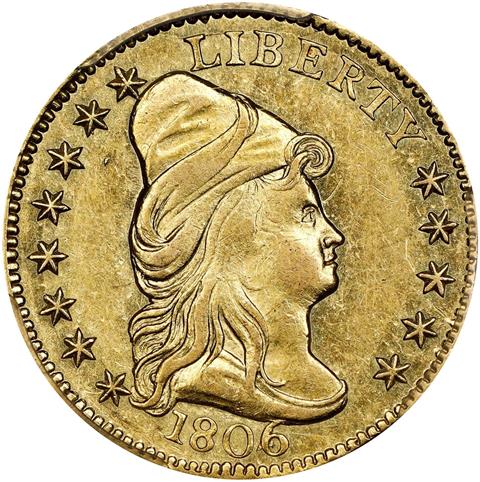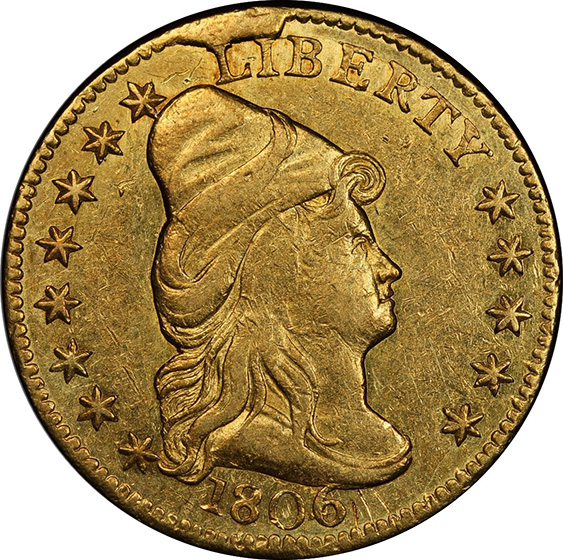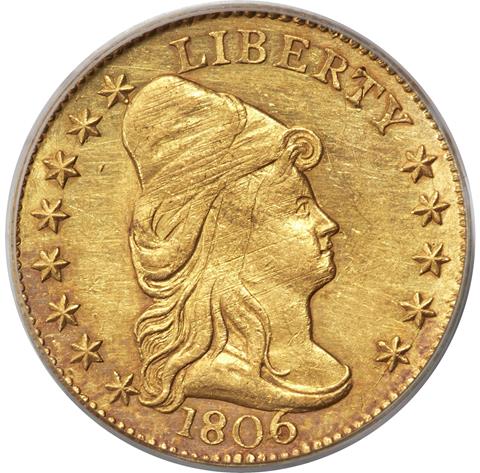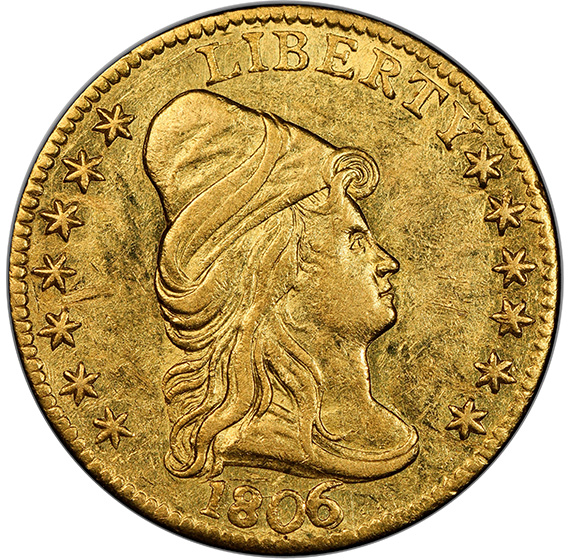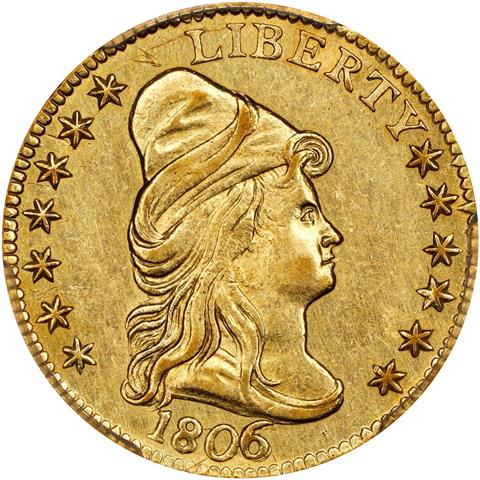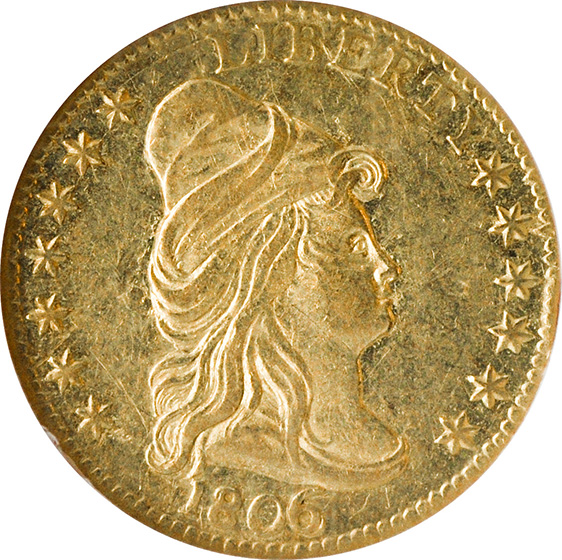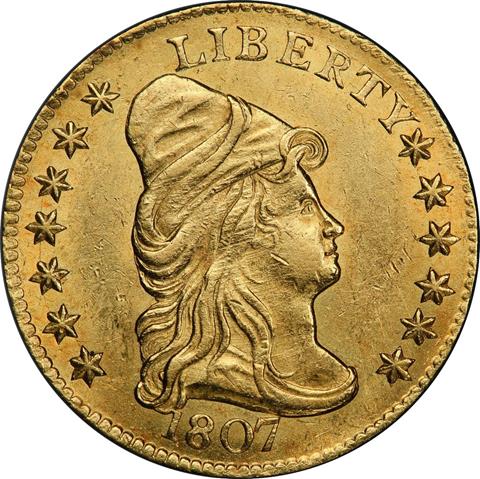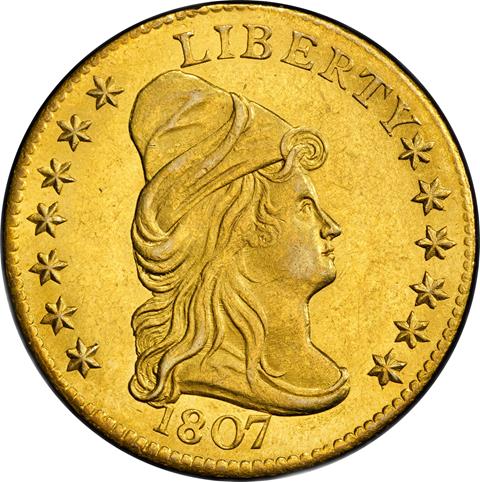Draped Bust $2.5
At the turn of the 19th century, two and a half dollars represented a considerable sum of money—five days wages for the average U.S. Mint employee. It was unlikely however, that anyone outside the Philadelphia Mint would see that amount in the form of the new quarter eagle coin: so few were made, and fewer still entered circulation. The denomination may as well not have existed at all. A few large Northeastern banks did occasionally order quarter eagles, but apparently more as a whim than out of necessity, as most remained in their vaults.
Although authorized by the Mint Act of 1792, by all appearances the coin was an unwanted stepchild: it was the last denomination made, and then only in such small quantities as to be of little use in commerce. The cent, half dollar, and half eagle took center stage during this era—they were the real workhorses. The paucity of early quarter eagles has a flip .... (Expand Text)
1796 DRAPED BUST $2.5, NO STARS AU55 PCGS
NO STARS. LUSTROUS PLANCHET WITH MINIMAL WEAR. FIRST YEAR OF ISSUE. ONE YEAR TYPE COIN. LESS THAN 125 SPECIMENS BELIEVED TO EXIST TODAY IN ALL GRADES.
$250,000.00
|
1797 DRAPED BUST $2.5 AU53 PCGS
CHOICE EVEN SLIGHTLY WORN LUSTROUS SURFACES. LESS THAN 30 SPECIMENS BELIEVED TO EXIST TODAY IN ALL GRADES. JUST 427 ORIGINALLY STRUCK.
$125,000.00
|
1797 DRAPED BUST $2.5 AU55 PCGS
VERY CHOICE SURFACES WITH JUST A SLIGHT AMOUT OF WEAR. LUSTER STILL VERY EVIDENT. ONLY 427 ORIGINALLY STRUCK. LESS THAN 30 SPECIMENS BELIEVED TO EXIST TODAY IN ALL GRADES.
$148,500.00
|
1797 DRAPED BUST $2.5 MS53 PCGS
WELL STRUCK WITH LUSTROUS SURFACES. ONLY 427 ORIGINAL STRUCK. LESS THAN 30 SPECIMENS KNOWN TODAY IN ALL GRADES.
$125,000.00
|
1805 DRAPED BUST $2.5 MS63 PCGS
NEAR GEM LUSTROUS SURFACES. ONLY ABOUT 150 SPRECIMENS BELIEVED TO EXIST TODAY IN ALL GRADES. JUST A SINGLE MS64+ GRADED HIGHER.
$175,000.00
|
1806/4 DRAPED BUST $2 1/2, 8X5 STARS MS61 PCGS
8X5 STARS. ORIGINAL GOLDEN SURFACES. ONLY 1,136 STRUCK. LESS THAN 100 BELIEVED TO EXIST TODAY IN ALL GRADES. JUST TWO COINS GRADED HIGHER AT PCGS WITH THE HIGHEST BEING A MS63.
$80,000.00
|
1806/4 DRAPED BUST $2.5, 8X5 STARS AU58 PCGS
8x5 STARS. EVEN SO SLIGHTLY WORN LUSTROUS SURFACES. LESS THAN 100 SPECIMENS BELIEVED TO EXIST TODAY.
$52,500.00
|
1806/4 DRAPED BUST $2.5, 8X5 STARS AU58 PCGS
8x5 STARS. SATIN LUSTROUS SURFACES. LESS THAN 100 COINS EXIST TODAY IN ALL GRADES. ONLY 6 COINS GRADED HIGHER AT PCGS.
$52,500.00
|
1806/4 DRAPED BUST $2.5, 8X5 STARS MS61 PCGS
8X5 STARS. NICE LUSTROUS PLANCHET. LESS THAN 100 SPECIMENS BELIEVED TO EXIST TODAY IN ALL GRADES. ONLY TWO COINS GRADED HIGHER AT PCGS.
$80,000.00
|
1806/5 DRAPED BUST $2.5, 7X6 STARS AU58 PCGS
CHOICE LUSTROUS SURFACES. VERY CLEAR OVERDATE. ONLY 480 STRUCK. LESS THAN 36 KNOWN TO EXIST TODAY IN ALL GRADES. JUST THREE COINS GRADED HIGHER AT PCGS. BASS PEDIGREE.
$80,000.00
|
1806/5 DRAPED BUST $2.5, 7X6 STARS AU58 PCGS
7x6 STARS. CHOICE LUSTROUS SURFACES JUST A HAIR AWAY FROM UNCIRCULATED. LESS THAN 35 SPECIMENS BELIEVE TO EXIST TODAY IN ALL GRADES. JUST 3 COINS GRADED HIGHER AT PCGS.
$80,000.00
|
1806/5 DRAPED BUST $2.5, 7X6 STARS AU58 NGC
7x6 STARS. LUSTROUS SURFACES ADORNS THIS SLIGHTLY WORN PLANCHET. JUST 25 TO 35 SPECIMENS BELIEVED TO EXIST IN ALL GRADES TODAY.
$62,500.00
|
1807 DRAPED BUST $2.5 MS62 PCGS
VERY CHOICE, LUSTROUS SURFACES. WELL STRUCK. ONLY 6,812 STRUCK. JUST SIX COINS GRADED HIGHER AT PCGS. LAST YEAR OF THE CAPPED BUST TO RIGHT TYPE.
$60,000.00
|
1807 DRAPED BUST $2.5 MS63 PCGS
GEM SATIN LUSTROUS SURFACES. VERY SCARCE IN THIS ESTEEMED GRADE. JUST TWO COINS GRADED HUGHER AT PCGS.
$160,000.00
|
1807 DRAPED BUST $2.5 MS63 PCGS
VERY CHOICE SATIN LUSTROUS SURFACES. JUST TWO COINS GRADED HIGHER AT PCGS. BASS PEDIGREE.
$160,000.00
|

